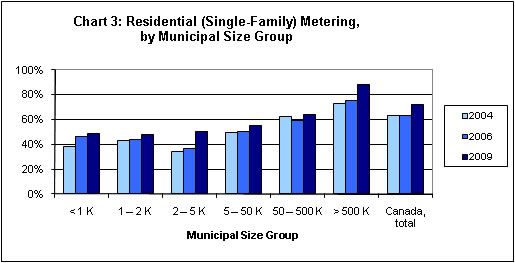
Previous page | Table of contents | Next page
Water meters allow users to be charged according to the actual volume of water used, as well as facilitating leak detection and providing water managers with valuable information on how water is used in their community. They represent an important component of any water efficiency program that involves the use of price signals to encourage water conservation.
The use of water meters in Canadian municipalities varies widely. While some communities are experimenting with state-of-the-art “smart” meters that can provide both the utility and the consumer with information on water use multiple times throughout the day, other communities do not use water meters at all. In general, however, the use of meters in both the residential and commercial sectors has increased over the past few decades. Among residences and businesses that receive municipal water supply, 72.1% of single-family residences are metered and 86.8% of commercial buildings (small offices/businesses with a maximum 1 inch or 25 mm connection) are metered.
The survey results show that, as in previous years, larger communities have higher rates of both residential and commercial metering. Almost all homes and businesses in the largest size group are metered, while roughly half of homes and businesses in communities of less than 3000 people are metered.
In general, commercial metering is more widespread than is residential metering. This trend is largely driven by a handful of provinces (Newfoundland and Labrador, Prince Edward Island, New Brunswick, Quebec, and British Columbia) where the incidence of commercial metering is much higher than residential metering.